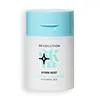What's inside
What's inside
 Key Ingredients
Key Ingredients

 Benefits
Benefits

 Concerns
Concerns

No concerns
 Ingredients Side-by-side
Ingredients Side-by-side

Water
Skin ConditioningRosa Damascena Flower Water
MaskingGlycerin
HumectantCaprylic/Capric Triglyceride
MaskingSesamum Indicum Seed Oil
EmollientCetyl Alcohol
EmollientHydroxyethyl Acrylate/Sodium Acryloyldimethyl Taurate Copolymer
Emulsion StabilisingPrunus Amygdalus Dulcis Oil
Skin ConditioningRosa Damascena Flower Oil
MaskingSodium Hyaluronate
HumectantHydroxyacetophenone
AntioxidantPhenoxyethanol
PreservativePrunus Armeniaca Kernel Oil
MaskingButyrospermum Parkii Butter
Skin ConditioningTocopheryl Acetate
AntioxidantHydroxyethyl Urea
HumectantDisodium EDTA
Sodium Ascorbyl Phosphate
AntioxidantBeta-Carotene
Skin ConditioningWater, Rosa Damascena Flower Water, Glycerin, Caprylic/Capric Triglyceride, Sesamum Indicum Seed Oil, Cetyl Alcohol, Hydroxyethyl Acrylate/Sodium Acryloyldimethyl Taurate Copolymer, Prunus Amygdalus Dulcis Oil, Rosa Damascena Flower Oil, Sodium Hyaluronate, Hydroxyacetophenone, Phenoxyethanol, Prunus Armeniaca Kernel Oil, Butyrospermum Parkii Butter, Tocopheryl Acetate, Hydroxyethyl Urea, Disodium EDTA, Sodium Ascorbyl Phosphate, Beta-Carotene
Ingredients Explained
These ingredients are found in both products.
Ingredients higher up in an ingredient list are typically present in a larger amount.
This ingredient is an emollient, solvent, and texture enhancer. It is considered a skin-softener by helping the skin prevent moisture loss.
It helps thicken a product's formula and makes it easier to spread by dissolving clumping compounds.
Caprylic Triglyceride is made by combining glycerin with coconut oil, forming a clear liquid.
While there is an assumption Caprylic Triglyceride can clog pores due to it being derived from coconut oil, there is no research supporting this.
Learn more about Caprylic/Capric TriglyceridePhenoxyethanol is a preservative that has germicide, antimicrobial, and aromatic properties. Studies show that phenoxyethanol can prevent microbial growth. By itself, it has a scent that is similar to that of a rose.
It's often used in formulations along with Caprylyl Glycol to preserve the shelf life of products.
Sodium Hyaluronate is hyaluronic acid's salt form. It is commonly derived from the sodium salt of hyaluronic acid.
Like hyaluronic acid, it is great at holding water and acts as a humectant. This makes it a great skin hydrating ingredient.
Sodium Hyaluronate is naturally occurring in our bodies and is mostly found in eye fluid and joints.
These are some other common types of Hyaluronic Acid:
Learn more about Sodium HyaluronateWater. It's the most common cosmetic ingredient of all. You'll usually see it at the top of ingredient lists, meaning that it makes up the largest part of the product.
So why is it so popular? Water most often acts as a solvent - this means that it helps dissolve other ingredients into the formulation.
You'll also recognize water as that liquid we all need to stay alive. If you see this, drink a glass of water. Stay hydrated!
Learn more about Water